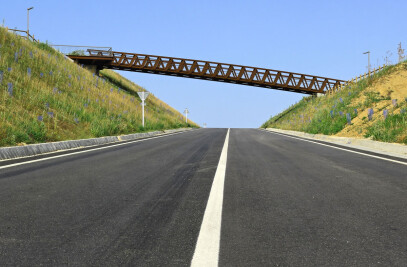The river Congost divides the city of Granollers into two parts. The city centre is located on the left-hand bank of the river while the right bank is mainly occupied by an industrial area. In order to prevent cars from entering downtown, the City Council wanted to improve the pedestrian accessibility to the car parking places available on the industrial area for people travelling to the city centre, chiefly on weekends. Consequently, in 2004 we were commissioned to design a new footbridge over the river to provide a new link between both sides.
The general design of the footbridge was strongly conditioned by the presence of the flood walls, whose top level is 1.20 metres above the level of the walkways that are set out on both sides of the river. We designed a 3 span, 20.49 - 29.95 - 20.49 metres each, continuous Corten steel deck formed by two longitudinal beams linked together at their bottom flanges by transversal I shaped beams. Corten steel was chosen due the beauty of its surface and because, in spite of its low maintenance feature, its appearance improves through its life.
The functional width of the footbridge is 3.10 metres. The steel structure is supported by the two abutments, placed behind the flood walls, and two piers, built at each side of the low flow section of the river. Both the abutments and the piers are founded on the rock stratum by means of 450 mm CFA piles the length of which varies from 6 metres at the piers to 7.50 metres at the east abutment. In order to give transparency to the parapets and, therefore, providing pedestrians with better views over the river, the main girders are Warren trusses. They have a slight curved shape in elevation and their depth varies, being maximum at the centre of the main span and minimum at its ends. The web members of the truss project beyond the lateral plates of the chords emphasizing its zig-zag shape and providing the trusses with an interesting play of shadows, one of its most characteristic features.
Since the upper chord of the truss has no bracing, in order to prevent it from lateral buckling, we improved the torsional stiffness of the bottom chord by giving it a hollow box shape, reinforced the lateral stiffness of the web members and increased the width of the top chord, to which we gave an inverted U shape. This allows enough room for the lights to be embedded. We chose high efficiency low maintenance LED technology lamps installed on each of the bays of the truss. This solution not only provides an agreeable street lighting along the crossing, but, by means of the combination of light and shadows, in the night it highlights the beauty of the structure.
The design of the abutments included the necessary ramps and stairs for the pedestrians to go up from the walkway to the deck. At both sides retaining walls were built into the abutments to enable the ramps to be set out in the limited available space. For the deck construction, wooden decking was placed over longitudinal joists supported by the transversal beams. On the ramps and stairs of the approaches, granite stone slab paving was provided. The supports of the handrails of the footbridge are fixed to the diagonal members of the truss and, to prevent people from falling, tensioned longitudinal stainless steel cables passing trough the web members were installed. Taking into account future needs, below the wood paving eight galvanised steel pipes were provided for utility services to be installed. The transversal beams that link the two main girders have eight holes to allow pipes to pass through them. Easy accessible chambers at each of the abutments facilitate the access to the pipes. The construction of the footbridge started at the end of December 2006. The CFA piles were first drilled and the pile caps constructed. Over them, the stems of the piers and the structure of the abutments with their retaining walls were built. The steel deck was fabricated in a town ten kilometres away from the site and was transported to the site in three sections, which were lifted from the river bed. The side spans were first put into place and, straight afterwards, the central section of the main span was lifted and welded. Next, the timber planks and the street lighting were placed and finally the ramps and the stairs at each side were built and the granite stone paving installed.
The bridge was open to the public at the end of July 2007.

































